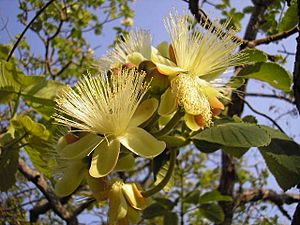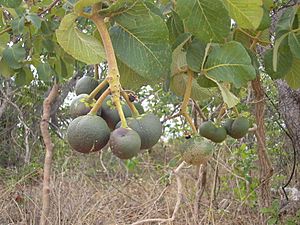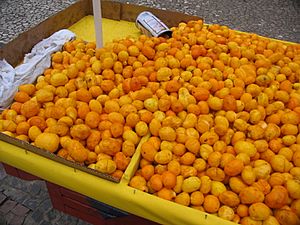Pequi facts for kids
Quick facts for kids Pequi |
|
|---|---|
 |
|
| Caryocar brasiliense flowers and leaves | |
| Scientific classification | |
| Genus: |
Caryocar
|
| Species: |
brasiliense
|
| Synonyms | |
|
Caryocar brasiliensis (lapsus) |
|
The Caryocar brasiliense, commonly known as pequi (pronounced pee-KEE or peh-KEE), is a special fruit from Brazil. It's also sometimes called the "souari nut." This fruit is very popular in certain parts of Brazil, especially in the central-western region. It's known for its unique taste and smell.
Contents
The Pequi Tree: Where It Grows
The pequi tree can grow quite tall, up to 10 meters (about 30 feet). You can find it mostly in the central Brazilian cerrado habitat. This area stretches from southern Pará down to Paraná and northern Paraguay.
The leaves of the pequi tree are big, tough, and hairy. They are shaped like a hand with three smaller leaves (leaflets) on each. Unlike many other trees in the cerrado, the pequi tree blooms with flowers during the dry winter months, usually from July to September.
The flowers are yellowish-white and have both male and female parts (hermaphroditic). They have many stamens, which are the parts that produce pollen. These flowers look a bit like a very large, pale St. John's Wort flower. Often, you'll find two dozen or more flowers growing together in one cluster.
How Pequi Flowers Get Pollinated
Pequi flowers are mainly pollinated by bats. Because bats are active at night, the flowers don't have a sweet smell. Instead, they produce a lot of thin, sugary liquid called nectar. The flowers open in the evening and keep making nectar all night long, stopping in the early morning. The last bit of nectar made around dawn seems to have more sugar, even if there's less of it.
At night, you might see moths, nocturnal wasps, and ants visiting the flowers. They might help with pollination, but bats are the most important.
During the day, bees and wasps visit the flowers to eat any leftover pollen. As the sun sets, hummingbirds might also visit. Some hummingbirds, like the fork-tailed woodnymph and the glittering-throated emerald, seem to visit pequi flowers regularly.
Interestingly, small birds like "tanagers" also visit the flowers around dusk. Species such as the guira tanager, white-lined tanager, and palm and sayaca tanagers really enjoy the pequi flower nectar. They spend a lot of time feeding on it when it's available. Even curl-crested jays have been seen near pequi trees at daybreak, possibly looking for insects attracted to the nectar.
It's not fully clear if birds help with pollination, especially since the female parts of the flower (stigmata) dry out by daybreak. They might just be enjoying an easy early-morning snack, as there isn't much other food like this available during the pequi flowering season.
The Amazing Pequi Fruit
Pequi fruits change color as they grow. They start dark purple, then turn olive green, and finally a buffy green when they are ripe. This ripening process takes about 5 to 6 months.
A ripe pequi fruit is about the size of an orange. Inside its skin, it has a few sections (usually 1 to 4) of yellow, soft pulp. This pulp has a strong, unique taste and smell that mixes sweet, fruity, and even a bit cheesy aromas. These smells come from natural chemicals called ethyl esters.
Inside the yellow pulp, there's a light-colored seed. This seed is covered by a blackish shell that has thin, tough, woody spines. However, some pequi trees grow fruits without these spines. Both the yellow pulp and the seed inside are safe to eat for humans and many animals, even meat-eating ones like the yellow-headed caracara.
Pequi: A Special Food and Tree
The yellow pequi pulp is a very popular food in Brazilian states like Goiás, Mato Grosso, Mato Grosso do Sul, and Minas Gerais. People eat it raw, cooked, or use it to flavor drinks. A very popular dish is pequi with rice and chicken.
If you eat pequi pulp, it can stain silver forks and spoons. It's often best to eat the raw fruit by hand. You need to be careful when scraping the pulp off the pit with your teeth. The tiny spines on the pit can break off and get stuck in your mouth, which can be quite painful and hard to remove.
After eating the pulp, the pits with their spines can be left to dry in the sun for a couple of days. Then, the spines can be scraped off with a knife or stick. The pit can then be cracked open to get the seed inside. From these seeds, a special edible pequi oil is made and sold. The seeds can also be roasted like peanuts and eaten with salt as a tasty snack.
Almost every part of the pequi tree can be used for food, medicine, or building materials. The pequi tree plays a very important role in the culture of the native people in Brazil's Cerrado region. Traditionally, people in rural Brazil plant pequi trees around their villages. New trees need to be planted regularly because the seeds take a long time to sprout.
In recent years, more and more people want pequi fruit. At the same time, the natural areas where pequi trees grow are being destroyed. This puts a lot of pressure on the pequi supply. Many people in the Cerrado region believe that pequi belongs to everyone, no matter where it grows. This idea shows how deeply rooted pequi is in their culture and cooking.
Pequi's Role in Nature
Because bats and possibly birds are so important for pollinating pequi trees, cutting down native woodlands can harm the amount of fruit the trees produce in the long run. This can happen even if the pequi trees themselves are not cut down.
Other native pollinators, like certain types of bees (for example, Melipona quadrifasciata and Scaptotrigona postica), also depend on pequi trees. They often build their nests in hollows within the trees. So, protecting the places where these pollinators live is very important for getting a good harvest of pequi fruits and other products from the tree.
See also
 In Spanish: Pequi para niños
In Spanish: Pequi para niños



